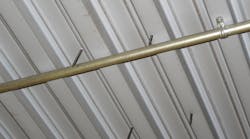How well do you know the Code? Think you can spot violations the original installer either ignored or couldn't identify? Here's your chance to moonlight as an electrical inspector and second-guess someone else's work from the safety of your living room or office. It's your turn to identify the violation.
Hint: A near miss
Find the Answer
Whew! That was a close call. A couple of those screws almost hit this EMT, which was secured directly to the underside of this corrugated sheet metal roof decking.
When repairing or replacing roof insulating material, roofers often need to use very long screws to ensure they penetrate the lowest portions of the corrugated deck. This is why Sec. 300.4(E) requires raceways, boxes, or cables to be spaced at least 1 ½ in. from the lowest surface of the roof decking. An Exception in this Section of the Code permits rigid metal conduit (RMC) and intermediate metal conduit (IMC) to be secured without the 1 ½ in. spacing requirements.
Section 358.12(1) states that EMT shall not be used “where, during installation or afterward, it will be subject to severe physical damage.” I think a screw penetrating right through the EMT would be considered “severe physical damage.” This EMT should have been spaced down from this roof deck.
Similarly, Sec. 410.10(F) applies the same 1 ½ in. spacing requirements to luminaires installed beneath metal-corrugated sheet roof decking.




